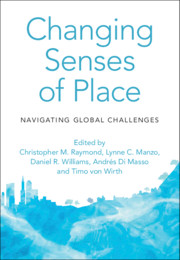Book contents
- Changing Senses of Place
- Changing Senses of Place
- Copyright page
- Dedication
- Contents
- Contributors
- Foreword
- Preface
- Acknowledgements
- Introduction
- Part I Climate Change and Ecological Regime Shifts
- Part II Migration, Mobility and Belonging
- Part III Renewable Energy Transitions
- Part IV Nationalism and Competing Territorial Claims
- 13 Ethnocentric Bias in Perceptions of Place
- 14 Sense of Place Between Spatial Justice and Urban Violence in Palestine
- 15 The Political Ecology of Place Meaning
- Part V Urban Change
- Part VI Technological and Legal Transformations
- Part VII Design and Planning Strategies for Changing Senses of Place
- Part VIII Conclusion
- Index
- References
14 - Sense of Place Between Spatial Justice and Urban Violence in Palestine
from Part IV - Nationalism and Competing Territorial Claims
Published online by Cambridge University Press: 15 July 2021
- Changing Senses of Place
- Changing Senses of Place
- Copyright page
- Dedication
- Contents
- Contributors
- Foreword
- Preface
- Acknowledgements
- Introduction
- Part I Climate Change and Ecological Regime Shifts
- Part II Migration, Mobility and Belonging
- Part III Renewable Energy Transitions
- Part IV Nationalism and Competing Territorial Claims
- 13 Ethnocentric Bias in Perceptions of Place
- 14 Sense of Place Between Spatial Justice and Urban Violence in Palestine
- 15 The Political Ecology of Place Meaning
- Part V Urban Change
- Part VI Technological and Legal Transformations
- Part VII Design and Planning Strategies for Changing Senses of Place
- Part VIII Conclusion
- Index
- References
Summary
Living under the Israeli occupation continues to affect all aspects of Palestinians’ everyday lives. This chapter considers the testimonies of Palestinians who were displaced after their homes were damaged during the urbicidal 2002 Israeli Ejtiyah on the old town of Nablus. This analysis is to assess the fundamental role of a sense of place, and the significance of its multiscalar nature, in gaining stability through rebuilding of damaged homes. The Palestinians experience home as a place where sense of place is lived and interpreted in multiscalar forms of spatial justice that relate to everyday life, community and socially constructed meaning, a state of mind, and as they relate to nostalgic memories and fear of displacement. Urban violence not only ruptures the spatial incubator of the Palestinians’ sense of place but also demonstrates the ways in which the colonial power dominance is controlling their homeland in general, and the very place where they intimately nurture it at home. In this context, Palestinians’ relationship with home and sense of place is considered a form of moqawameh (resistance) and sumoud (steadfastness) against the Israeli colonial strategies.
Keywords
- Type
- Chapter
- Information
- Changing Senses of PlaceNavigating Global Challenges, pp. 182 - 192Publisher: Cambridge University PressPrint publication year: 2021



